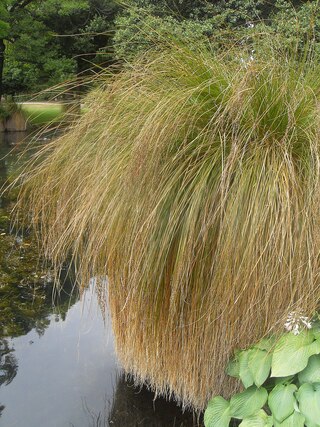
Ornamental grasses are grasses grown as ornamental plants. Ornamental grasses are popular in many colder hardiness zones for their resilience to cold temperatures and aesthetic value throughout fall and winter seasons.

Carex is a vast genus of over 2,000 species of grass-like plants in the family Cyperaceae, commonly known as sedges. Other members of the family Cyperaceae are also called sedges, however those of genus Carex may be called true sedges, and it is the most species-rich genus in the family. The study of Carex is known as caricology.
NVC community CG2 is one of the calcicolous grassland communities in the British National Vegetation Classification system. It is one of three short-sward communities associated with heavy grazing, within the lowland calcicolous grassland group, and is regarded as "typical" chalk grassland.

Comandra is a monotypic genus containing the single species Comandra umbellata. Its common names include bastard toadflax, umbellate bastard toadflax, and common comandra. The plant has a disjunct distribution; its four subspecies occur in North America and the Mediterranean.

Uncinia is a genus of flowering plants in the family Cyperaceae, known as hook-sedges in Australia and as hook grasses or bastard grasses in New Zealand. The genus is characterised by the presence of a long hook formed by an extension of the rachilla, which is used to attach the fruit to passing animals (epizoochory), especially birds, and it is this feature which gives the genus its name, from the Latin uncinus, meaning a hook or barb.
NVC community CG5 is one of the calcicolous grassland communities in the British National Vegetation Classification system. It is one of four communities of rank, tussocky grassland associated with low levels of grazing, within the lowland calcicolous grassland group.

Tussock grasses or bunch grasses are a group of grass species in the family Poaceae. They usually grow as singular plants in clumps, tufts, hummocks, or bunches, rather than forming a sod or lawn, in meadows, grasslands, and prairies. As perennial plants, most species live more than one season. Tussock grasses are often found as forage in pastures and ornamental grasses in gardens.

Tussock grasslands form expansive and distinctive landscapes in the South Island and, to a lesser extent, in the Central Plateau region of the North Island of New Zealand. Most of the plants referred to as tussocks are in the genera Chionochloa, Festuca, and Poa, also Carex.

Carex scoparia is a species of sedge known by the common names broom sedge and pointed broom sedge. It should not be confused with the unrelated grass species known as "broom sedge," Andropogon virginicus.

Carex secta is a sedge from the Cyperaceae family that is endemic to New Zealand. It grows in wetlands. Its Māori names include purei, pukio and makura.

Harry Howard Barton Allan was a New Zealand teacher, botanist, scientific administrator, and writer. Despite never receiving a formal education in botany, he became an eminent scientist, publishing over 100 scientific papers, three introductory handbooks on New Zealand plants, and completing the first volume of a flora in his lifetime.

Carex uncinata, the Hawai'i birdcatching sedge, hook grass, hook sedge, bastard grass, kamu or matau-a-maui, is a species of flowering plant in the sedge family, Cyperaceae.

Austroderia is a genus of five species of tall grasses native to New Zealand, commonly known as toetoe. The species are A. toetoe, A. fulvida, A. splendens, A. richardii and A. turbaria. They were recently reclassified in 2011 from the genus Cortaderia, although their distinctiveness had been recognized as early as 1853.

Carex sylvatica is a species of sedge found in deciduous woodlands across Europe. It typically reaches 60 cm (24 in) tall, and has an inflorescence made up of 3–5 pendent female spikes and a single male spike. It is also used as a garden plant, and has been introduced to North America and New Zealand.

Carex inversa, commonly known as knob sedge, is a species of sedge of the family Cyperaceae that is native to parts of Australia and New Zealand and has also been introduced into Great Britain.

Carex buchananii, common names Buchanan's sedge, cutty grass, is a species of sedge. It is endemic to New Zealand, being found on both the North and South Islands.

Carex erebus is a member of the sedge family and is found on the Antarctic Islands of Australia and New Zealand.

Carex corynoidea, fish hooks, is a species of flowering plant in the sedge family Cyperaceae, native to New Zealand. A perennial of montane forests, its chromosome number is 2n = 88.
Carex healyi, the harsh-leaved bastard grass, is a species of flowering plant in the family Cyperaceae, native to New Zealand. Found in a wide variety of habitats but preferring semi-shade, its chromosome number is 2n = 88.
Carex erythrovaginata, the lax bastard grass, is a species of flowering plant in the family Cyperaceae, native to New Zealand. A stout tussock-former reaching 75 cm (30 in), its dark green leaves are strongly scabrid.















